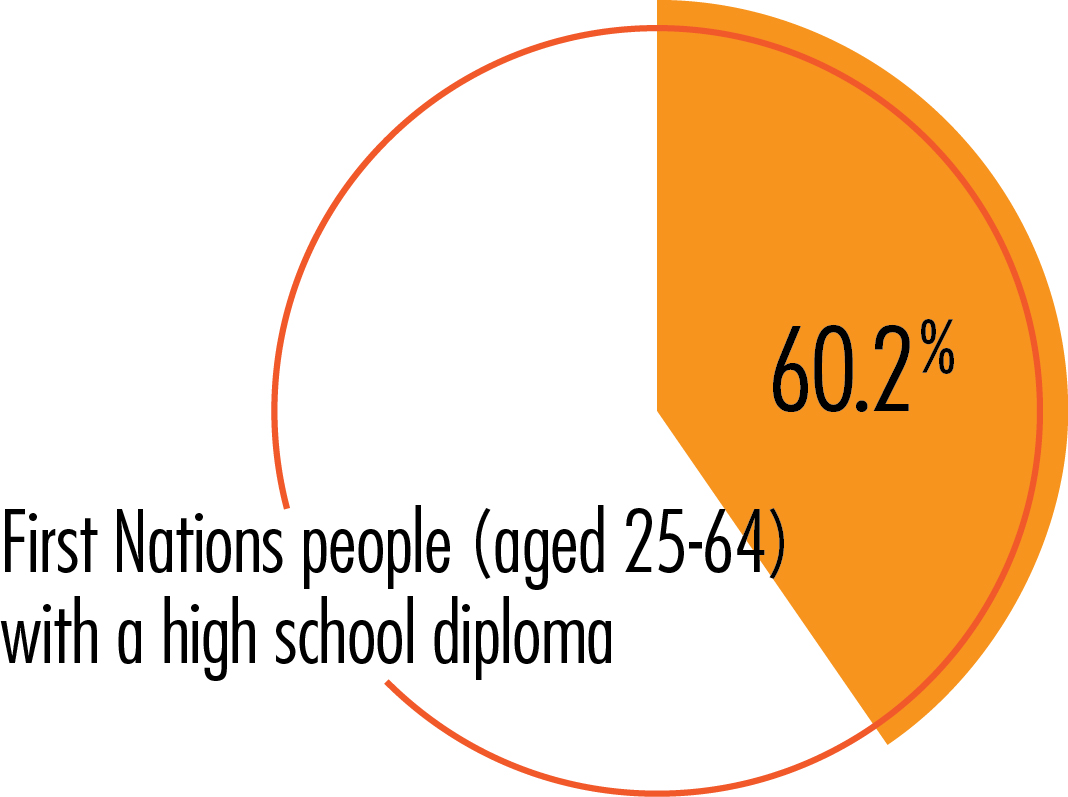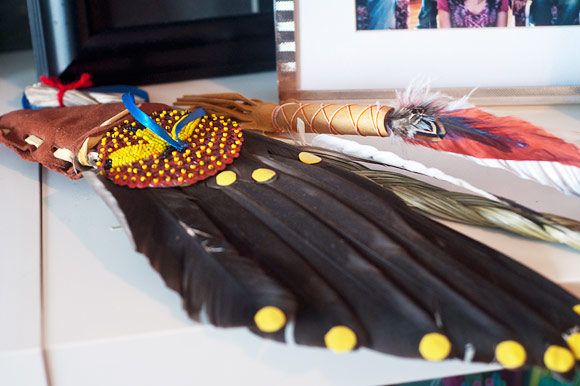Canadians' optimism for the future is less easily accessible for the descendants of the land's earliest inhabitants. In the spring of 2015, Ottawa hosted the Truth and Reconciliation Commission of Canada (TRC) to examine the legacy of federal government-funded Indian Residential Schools, which for over 120 sought to strip tens of thousands of Aboriginal children of their family ties and cultural identity. The event served as a stark reminder of the collaborative strides that must be made by both government and the private sector to work toward breaching Aboriginal achievement gaps perpetuated by centuries of systemic disenfranchisement and exclusion.
Data from the
2011 National Household Survey show that some 1,400,685 people in Canada had Aboriginal identity, representing 4.3% of the total Canadian population. It's a figure that's steadily grown since the 1996 Census, with
nearly half of that population under the age of 25. At a moment where such a significant proportion of its population is poised to enter the workforce, Canada finds itself at a critical juncture in facilitating the educational and professional advancement of Aboriginal communities while also honouring their unique history, cultural perspective, and inherent rights. It's a process that, as national strategic gathering sessions and corporate initiatives will attest, must involve direction from Aboriginal communities themselves.
“Aboriginal organizations must have a stake, and a real voice,” says Scott Haldane. The President and CEO of YMCA Canada, Haldane served as the Chair of the National Panel on First Nations Education from 2011 to 2012, reporting to both the Minister of Aboriginal and Northern Affairs and the Assembly of First Nations. The panel was convened with the intention of making recommendations that included possible legislation to close the substantial education gap between Aboriginal students on reserves versus the general population. However, those recommendations have yet to be implemented.
By
recent estimates from the Chiefs Assembly on Education, 43.7 percent of Aboriginal people aged 15 and older do not hold any postsecondary certificate or diploma, compared with 23.1 percent of the Canadian population. According to the
National Household Survey from 2011, only 60.2 percent of First nations people between the ages of 25 to 64 had completed at least a high school diploma.

“The gaps still exist,” Haldane says. “Education funding inequities are still existent. Both the human cost and economic impact of those inequities remain with us.”
Jessica Bolduc, the Executive Director of the 4Rs Youth Movement—a collaboration of 14 national organizations working with youth to unify Indigenous and non-Indigenous young people to cultivate understanding and action—believes that an inclusive process is essential to correct structural inequities. An Anishinaabe kwe from Sault Ste. Marie Ontario, Bolduc works with other young Aboriginal leaders to foster arts-based economies, social infrastructure, and hub spaces for Northern Ontario change-makers. It's an undertaking that, she believes, must begin with a re-shifting of perspectives that puts Indigenous approaches first.
“Our framework of facilitation is centred in indigenous knowledge,” she says. “Young indigenous people are being brought into leadership spaces, teaching non-aboriginal people to be allies and supporters.”
Storytelling and social media play a significant role in shifting narratives, with the goal of holding cultural conversations about issues that have both local and national impact. She adds that forming strong relationships between indigenous and non-indigenous people at an early age is essential to make change. Another key element in facilitating Aboriginal advancement through partnerships involving non-Aboriginal leaders: listening.
 Photo by Tanja-Tiziana
Photo by Tanja-Tiziana
“Sometimes there are trust issues that need to be addressed before we can even have conversation about partnership,” says Bolduc. “It's important to give people respect and acknowledge that their life experiences are valid. A common narrative that I see is that non-Aboriginal people have a reluctance to believe and support what Aboriginal people say that they need. People need to do personal work before they can even think about approaching an organization.”
For organizations interested in connecting with Aboriginal communities, Bolduc points to workshops facilitated by Reconciliation Canada that are aimed at corporate and not-for-profit boards. 4Rs also works with organizations to facilitate inter-cultural outreach.
Within the frame of enterprise, the Canadian Council for Aboriginal Business has worked closely with companies across Canada to develop Aboriginal inclusion strategies in the lead-up to the TRC, guiding the approaches of major corporations like TD (whose
Aboriginal Economic Prosperity report refers to the Council's 2013 survey of Aboriginal Economic Development Corporations) and IBM Canada. What has begun to come forth are strategies to internally facilitate the success of Aboriginal professionals, in addition to building inter-organizational awareness and engaging on the ground in communities.
IBM Canada consulted with the Aboriginal Human Resources Council to create a National Aboriginal Strategy that would address the four pillars of employment, procurement and business development, community relations and community investment. Internally, the company is focused on building HR capacity for recruiting, retaining, and promoting Aboriginal people within the company, and also on creating expanded awareness within and across the sector. But, as IBM Canada's National Aboriginal Program Executive Mary Jane Loustel points out, corporate citizenship work aimed at building strong communities is essential.
“Some nations don't have schools beyond grade eight and kids have to leave school," says Loustel. “There are lots of disincentives to complete education. It's important for us to look to solutions."
On-the-ground capacity building is one of these. Every summer, IBM sends employees out to Aboriginal communities across Canada to deliver technology camps to middle grade students and, in the process, encourage IBM staff to learn more about the students' corresponding communities and cultures. Loustel, who is herself Aboriginal, explains that the emphasis is on building knowledge that not all Aboriginal communities share the same exact challenges or cultural beliefs.
If the process sounds drawn-out, that's because it is. And as Dave Robitaille, Director of Corporate Citizenship and Corporate Affairs for IBM Canada, that's exactly as it should be.
"It's a long journey,” says Robitaille. “This is not a situation where we can float in, drop a big cheque or announce a big program and go off to the next thing. It's about building trust, relationships, and meaningful progress tomorrow after what we've done today."
As Robitaille sees it, every organization has its own strengths and opportunities to make change. By working together on those things, everyone is able to accomplish more. Canada can only become stronger economically and socially if we work on repairing those areas that need the most long-term help.
Haldane, meanwhile, is heartened by the numerous organizations that have implemented strategies aimed at Aboriginal advancement. He advises that companies and coalitions start by establishing two key principles: firstly, to recognize that other organizations within Aboriginal communities—such as 4Rs Youth Movement—are already working within the sphere of community and economic advancement, and to reach out to them to build upon, and enable, their capacity rather than attempt to duplicate existing models; and secondly, to approach Aboriginal community advancement as a blank slate.
“You have to start with the reverse [attitude] of what is seen as leadership,” Haldane says. “Rather than approach from a point of 'we have answers,' you must start from a perspective of 'I know nothing.' In this area, you cannot be successful unless you approach knowing that you are there to learn.”
There is hope. Rates of educational completion are higher for younger members of Aboriginal communities, which means that today's young Aboriginals are better equipped than their parents to make waves and fill boardrooms. But there's still a long way to go before a collective narrative of Aboriginal success replaces that of hardship, and a shift that will require cooperation and collaboration from across sectors.
